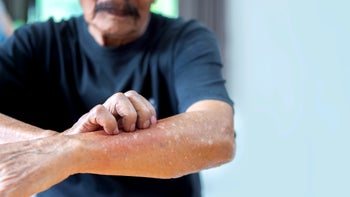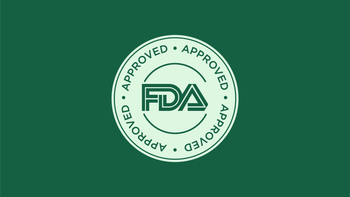
Lupus Rash in Pictures: How to Recognize and Treat It
Key takeaways:
Lupus is an autoimmune disease that can affect the skin, joints, and internal organs.
A skin rash may be the first sign of lupus, and it usually develops on the face, arms, or chest.
The lupus rash can be triggered by sun exposure, so it’s important to use sunscreen every day if you have lupus.
Access savings on related medications
Table of contents
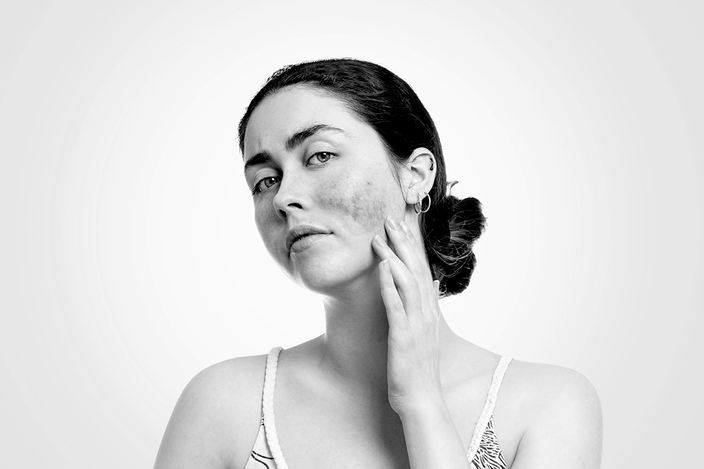
Lupus is an autoimmune condition that can affect the skin, joints, and internal organs. It can be hard to diagnose because its symptoms are often mistaken for other diseases. Lupus can range from mild, with symptoms limited to the skin, to severe, affecting many different parts of the body and organs.
Skin rashes are common in all types of lupus. In fact, lupus rash affects 70% to 80% of people with lupus. And in 20% of cases, a rash is the first noticeable sign of lupus. So it helps to know what to look for.
What does a lupus rash look like?
The lupus rash is most common on the face and other sun-exposed skin, like the arms. Depending on where it is on your body, and your underlying skin tone, a lupus rash can look different for different people. Here are some examples.
Butterfly rash

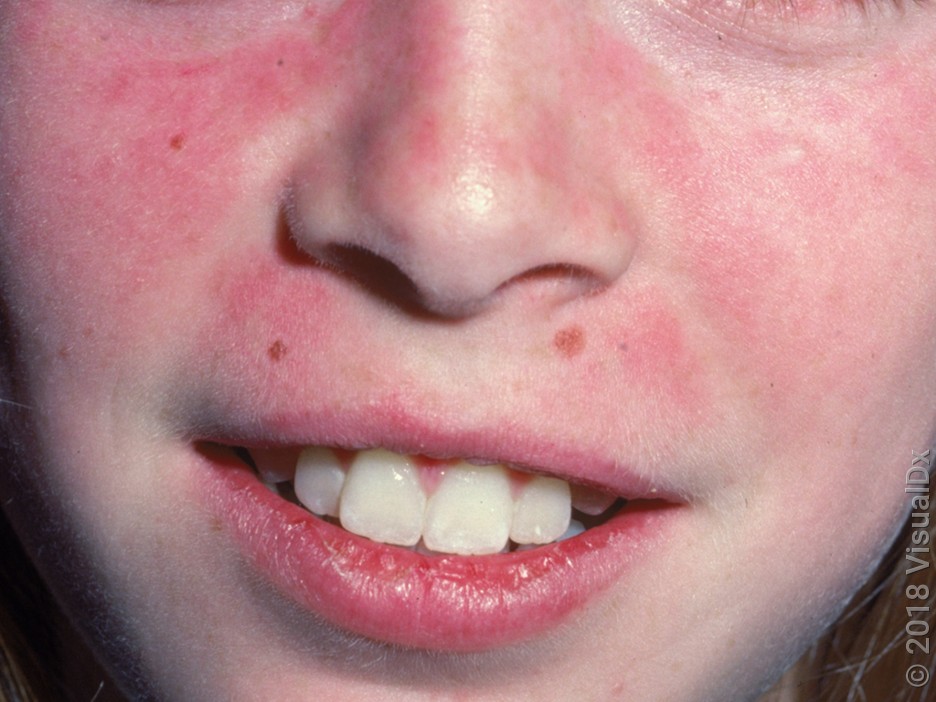
The butterfly rash is a telltale sign of lupus. It’s a flat or raised rash that develops in a butterfly shape over the cheeks and the nose. In lighter skin, the rash is red or pink, and it can be mistaken for blushing or a sunburn. In darker skin tones, the rash can look dark red, dark brown, or a darker shade than surrounding skin.
A butterfly rash usually doesn’t have any symptoms, but some people describe it as a little painful or itchy. In more severe cases, it can even feel hot. A butterfly rash doesn’t leave scars or discoloration when it goes away.
Sun-sensitive lupus rash on arms, legs, or chest
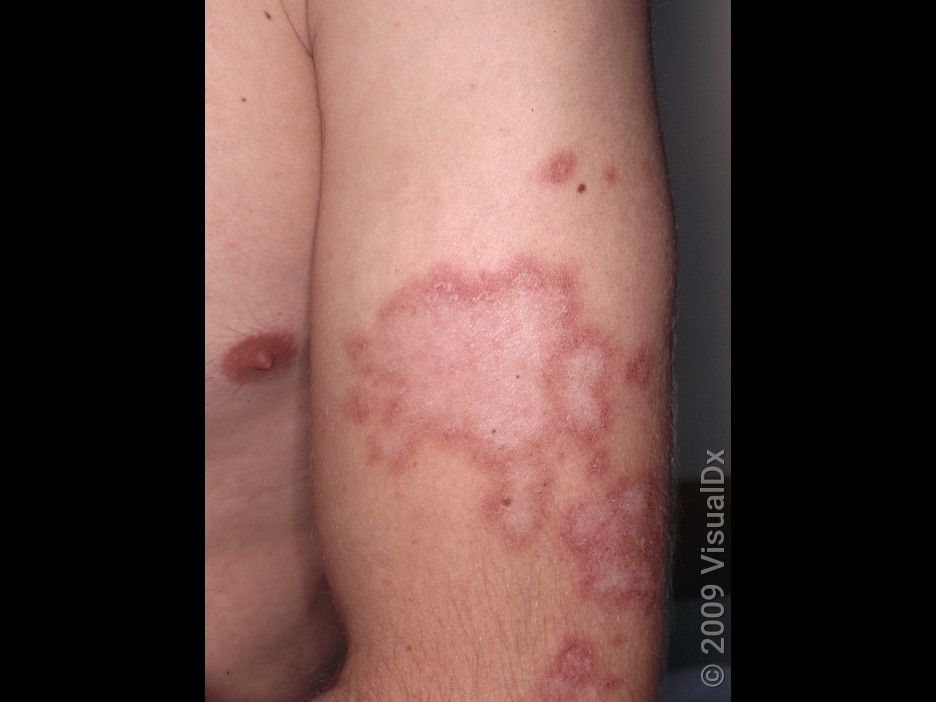

People with lupus get rashes that flare in areas of skin exposed to the sun. In addition to the face, sun-sensitive rashes can affect:
Chest
Upper back
Arms
Neck
This type of lupus rash is usually scaly. In lighter skin, it looks red or pink. In darker skin tones, it looks purple or brown. In some cases, it forms ring shapes on the skin.
The rash doesn’t come on immediately after sun exposure. It can take a few days to a few weeks to appear. For some people, the rash can be quite itchy. This type of rash doesn’t scar the skin when it heals, but it can leave patches of lighter or darker skin, which get better with time.
Discoid lupus rash

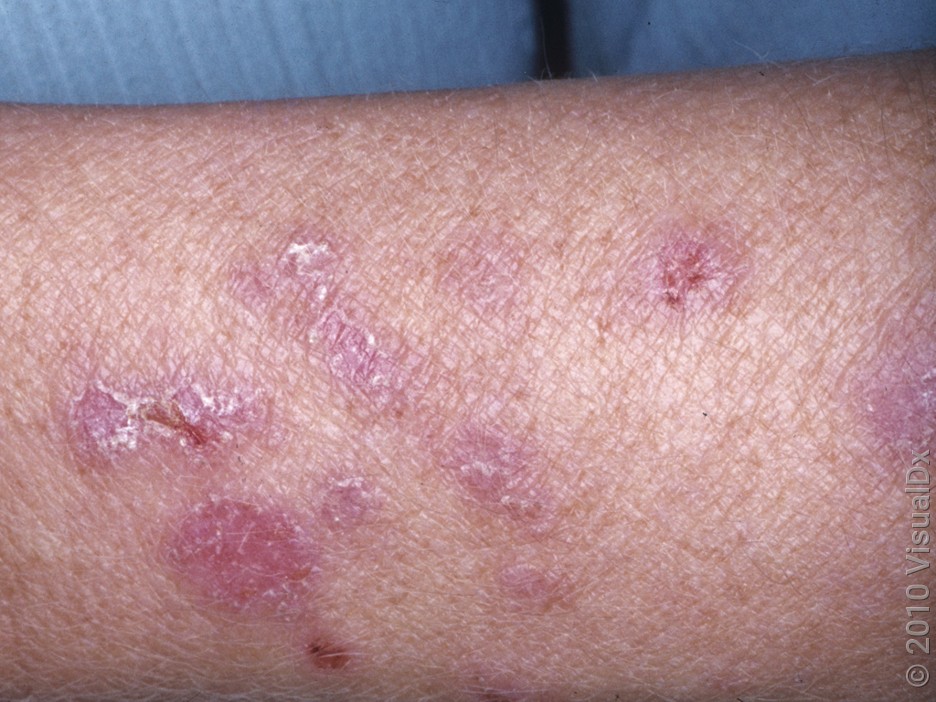
Discoid lupus also appears in sun-exposed areas. It’s most common on the face and scalp, but it can affect other parts of the body, too. The rash consists of thick, coin-shaped patches of scarred skin that can be red or dark. Discoid lupus also typically causes hair loss in the affected skin, because skin scarring plugs and destroys the hair follicles.
Some people feel mild itching or pain with these rashes. Discoid lupus can leave permanent scars, skin discoloration, and lasting hair loss.
Sun sensitivity and lupus: If you have lupus, learn how unprotected sun exposure may be making your rash and other symptoms worse.
More than skin deep: Read how one woman’s mysterious lifelong symptoms ended up in a lupus diagnosis.
Living with lupus as a Black woman: See one woman’s mission to educate other women of color about lupus and kidney failure.
What causes lupus rash?
Lupus is a condition that can cause inflammation in any part of the body. It’s an autoimmune condition, meaning your immune system mistakenly reacts against your own body, including your skin. Experts don’t know why this happens, but it’s likely a combination of genetics and environment.
Lupus can affect anyone, but it’s much more common in women, especially women ages 15 to 44. Lupus also affects people from certain ethnic backgrounds more than others. For example, you have a higher risk of having lupus if you are:
Black
Hispanic and Latino
Asian
Indigenous

Looking to save on BENLYSTA (belimumab)?
BENLYSTA is for people 5+ with active SLE (lupus) or active lupus nephritis on other lupus medicines. Not for people with severe active central nervous system lupus.

Do not use BENLYSTA if you are allergic to belimumab or any ingredients in BENLYSTA.
The most important information about BENLYSTA
Immunosuppressive agents, including BENLYSTA, can cause serious side effects. Some of these may cause death.
• Infections:
fever, chills, pain or burning with urination, urinating often, coughing up mucus, or warm, red, or painful skin or sores on your body. Infections could be serious, leading to hospitalization or death.
• Allergic (hypersensitivity) reactions:
itching, swelling of the face, lips, mouth, tongue, or throat, trouble breathing, anxiousness, low blood pressure, dizziness or fainting, headache, nausea, or skin rash. Serious allergic reactions can happen the day of, or in days after, receiving BENLYSTA and may cause death.
• Mental health problems and suicide:
thoughts of suicide or dying, attempt to commit suicide, trouble sleeping (insomnia), new or worse anxiety or depression, acting on dangerous impulses, other unusual changes in your behavior or mood, or thoughts of hurting yourself or others.
Before receiving BENLYSTA, discuss with your healthcare provider if you:
• think you have an infection or have infections that keep coming back. Do not use BENLYSTA if you have an infection unless your healthcare provider tells you to.
• have or have had mental health problems such as depression or thoughts of suicide.
• have recently received or may need a vaccination. If you are receiving BENLYSTA, you should not receive live vaccines.
• are taking any medicines, including prescription, over-the-counter, vitamins, and herbal supplements.
• are allergic to other medicines.
• are receiving other biologic medicines.
• have or have had any type of cancer.
• have any other medical conditions.
• are pregnant or plan to become pregnant. It is unknown if BENLYSTA will harm your unborn baby. Talk to your healthcare provider about whether to prevent pregnancy while on BENLYSTA. If you choose to prevent pregnancy, you should use an effective method of birth control for at least 4 months after the final dose of BENLYSTA.
• become pregnant while receiving BENLYSTA, talk to your healthcare provider about enrolling in the BENLYSTA Pregnancy Registry. You can enroll in this registry by calling 1-877-311-8972 or go to https://mothertobaby.org/ongoing-study/benlysta-belimumab/
• are breastfeeding or plan to breastfeed. It is unknown if BENLYSTA passes into your breast milk.
Possible side effects of BENLYSTA
• Progressive multifocal leukoencephalopathy (PML). PML is a serious and life-threatening brain infection. PML can result in death or severe disability. Tell your healthcare provider right away if you notice any new or worsening medical problems: memory loss, trouble thinking, dizziness or loss of balance, difficulty talking or walking, or loss of vision.
• Cancer. Medicines that affect the immune system, including BENLYSTA, may increase your risk of certain cancers.
The most common side effects of BENLYSTA are nausea, diarrhea, fever, stuffy or runny nose and sore throat, persistent cough, trouble sleeping, leg or arm pain, depression, headache, and pain, redness, itching, or swelling at the site of injection (when given subcutaneously). These are not all the possible side effects of BENLYSTA. Call your doctor for medical advice about side effects.
Please see Prescribing Information and Medication Guide for BENLYSTA.
What is BENLYSTA?
BENLYSTA is a prescription medicine used to treat people 5 years of age and older with active systemic lupus erythematosus (SLE or lupus) or active lupus nephritis (LN) (lupus-related kidney inflammation) who are receiving other lupus medicines. It is not known if BENLYSTA is safe/effective in people with severe active central nervous system lupus.
It is not known if BENLYSTA, given under the skin, is safe/effective in:
• children with SLE under 5 years of age or weighing less than 33 lbs
• children with LN under 18 years of age
It is not known if BENLYSTA, given in a vein (intravenously), is safe and effective in children less than 5 years of age.
BENLYSTA IV is available as 120 mg in a 5-mL single-dose vial and 400 mg in a 20-mL single-dose vial. BENLYSTA SC is available as a 200 mg/mL single-dose autoinjector and prefilled syringe.
Trademarks owned by or licensed to the GSK group of companies.
©2024 GSK or licensor.
PMUS-BELWCNT240036 October 2024
Produced in USA.
Lupus rash symptoms
The symptoms of lupus rashes depend on the individual, the type of rash, and where the rash is on the body. Many people don’t have any symptoms. Some describe a mild itch or soreness. Sometimes the butterfly rash can feel warm and tender, like a sunburn. If a lupus rash has any symptoms, they usually improve with treatment.
One common symptom of lupus rashes is hair loss. Some people develop coarse, dry hair around the hairline that breaks easily leaving short hairs known as “lupus hair.” This usually grows back after lupus treatment. Other people with discoid lupus (see above) can develop hair loss that’s usually permanent.
Lupus is more than just skin deep. It can affect many other organs, too. In addition to skin rashes and hair loss, some early lupus symptoms include:
Fatigue (feeling tired)
Joint pain
Skin sensitivity to sunlight
Muscle soreness
Fevers
How to tell if it’s a lupus rash or something else
People commonly mistake lupus rashes for a sunburn or other common skin conditions. A dermatologist can usually tell them apart. But sometimes it can be hard. A skin biopsy can help figure it out in these cases. Here are some conditions that are not skin lupus, but may look similar to it:
Rosacea: Like a lupus rash, rosacea can also cause red patches across the nose and cheeks. Rosacea is more likely if you have acne-like spots and eye symptoms, like dryness or burning.
Sunburn: Like sunburn, skin lupus gets worse in the sun. But sunburns are usually flat and red, and affect all sun-exposed skin.
Acne: Both acne and lupus commonly affect the face. But if you see pimples, blackheads, or cysts, then it’s probably acne.
Seborrheic dermatitis: This can cause a scaly, red rash around the nose. But, unlike lupus, seborrheic dermatitis often involves the skin crease between the nose and cheek (the nasolabial fold) as well.
Treatments for lupus rash
The treatment you’ll get for lupus depends on whether your lupus just affects your skin, or other organs, too. For milder cases in the skin only, the first-choice treatment is a prescription topical cream or ointment. If you have discoid lupus, you might need steroid injections into the spots. Systemic lupus usually requires medications to calm the inflammation or lower the immune system.
Best creams for a lupus rash
The best cream for a lupus rash is usually a prescription topical steroid. This is because they work well, have been used the longest, and are widely available. Choosing the right one depends on which area of the body you’re treating:
Face: You’ll want to use a lighter option like hydrocortisone 2.5% since the skin on the face is thinner and more sensitive.
Arms and legs: You can use medium-strength steroids like mometasone furoate 0.1% cream or triamcinolone acetonide 0.1% cream.
Scalp, hands, or feet: Stronger steroids like clobetasol work best because the skin in these areas is thicker.
Other prescription creams that can be used for lupus are calcineurin inhibitors, like pimecrolimus cream and tacrolimus ointment. These don’t have as many long-term side effects as steroids, but there also isn’t as much research behind them.
Other medications to treat skin lupus
If you have extensive skin rashes, you may need one or more of these medications:
Antimalarial medications, like hydroxychloroquine and chloroquine, work 50% to 90% of the time.
Steroid pills are an option for short-term relief. While they work well and quickly, you can’t use them in the long term because of the side effects.
Other medications that lower the immune system, like methotrexate (Rheumatrex) and mycophenolate mofetil (Cellcept), are a longer-term option in severe cases.
For people who also have lupus that affects the kidneys (lupus nephritis), there’s an FDA-approved biologic called Benlysta (belimumab).
Avoid the sun
Lastly — but perhaps most importantly — minimize your sun exposure. Exposure to sunlight can cause symptoms of lupus flares, both in the skin and in your organs. But the reaction doesn’t necessarily happen right away. It can be delayed anywhere from 3 days to 3 weeks. Because of this, sun protection with a broad-spectrum sunscreen and sun-protective clothing needs to be part of everyday life.
Natural remedies to treat a lupus rash
The best thing you can do for a lupus rash is to avoid the sun and other things in your environment that trigger your lupus.
There’s not enough good evidence to support natural remedies for skin lupus. But here are some supplements that show promise:
Omega-3 fatty acids/fish oil
N-acetylcysteine
But be careful — some natural supplements (like alfalfa sprouts, echinacea, and melatonin) may actually worsen lupus symptoms. They can also interact with prescription medications. It’s always best to check with your healthcare team before trying new supplements.
The bottom line
Lupus is a complex autoimmune condition that can affect every organ of the body — including the skin. A typical lupus skin rash is a common first symptom and can be a clue to the diagnosis. Early diagnosis and treatment are key to better outcomes. It isn’t always easy to tell when a rash is from lupus or something else. So, if you aren’t sure, don’t put off seeing your primary care provider or a skin specialist.
Why trust our experts?



Images used with permission from VisualDx (www.visualdx.com).
References
Achtman, J. C., et al. (2015). Pathophysiology of cutaneous lupus erythematosus. Arthritis Research & Therapy.
American Osteopathic College of Dermatology. (n.d.). Biopsy.
Cambow, N. (2016). August’s topic of the month – Coping with itchy rashes. Lupus UK.
Centers for Disease Control and Prevention. (2024). People With Lupus.
Chanprapaph, K., et al. (2019). Nonscarring alopecia in systemic lupus erythematosus: A cross-sectional study with trichoscopic, histopathologic, and immunopathologic analysis. Journal of the American Academy of Dermatology.
Cojocaru, M., et al. (2011). Manifestations of systemic lupus erythematosus. Maedica.
DermNet. (2022). Discoid lupus erythematosus.
Greco, C. M., et al. (2013). Updated review of complementary and alternative medicine treatments for systemic lupus erythematosus. Current Rheumatology Reports.
Human Genome Sciences, Inc. (2017). Benlysta [package insert].
Kuhn, A., et al. (2010). Cutaneous lupus erythematosus: Update of therapeutic options part I. Journal of the American Academy of Dermatology.
Kuhn, A., et al. (2010). Cutaneous lupus erythematosus: Update of therapeutic options part II. Journal of the American Academy of Dermatology.
Lehmann, P., et al. (2009). Clinic and pathophysiology of photosensitivity in lupus erythematosus. Autoimmunity Reviews.
Leuchten, N., et al. (2018). Early symptoms of systemic lupus erythematosus (SLE) recalled by 339 SLE patients. Lupus.
Lupus Foundation of America. (n.d.). What role do sex and gender play in lupus?
Oakley, A., et al. (2022). Discoid lupus erythematosus. DermNet.
Okon, L. G., et al. (2013). Cutaneous lupus erythematosus: Diagnosis and treatment. Best Practice & Research: Clinical Rheumatology.
Solhjoo, M., et al. (2023). Drug-induced lupus erythematosus. StatPearls.



